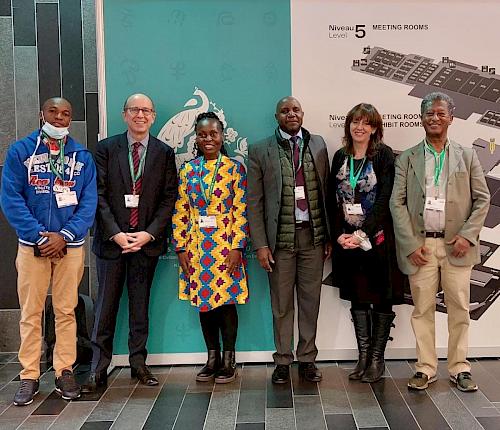Landmark Global biodiversity Framework agreed – focus must now be on implementation and resources
Adopted by 196 countries under the UN Convention on Biological Diversity, TRAFFIC welcomes the adoption of the Kunming-Montreal Agreement at CBD CoP15, including the 23 Targets of the Global Biodiversity Framework (GBF) to halt and reverse biodiversity loss by 2030. Yet, TRAFFIC advises that celebrating the end of years-long negotiations should not overshadow the urgent need for immediate action and funding.
This is a historic framework for nature and people. The focus must now be on implementation and resources, including to ensure that biodiversity is sustainably used and managed and nature’s contributions to people are valued, maintained and enhanced, supporting sustainable development for the benefit of present and future generations."
Richard Scobey, TRAFFIC’s Executive Director
To achieve this goal, TRAFFIC is particularly pleased that the final deliberations on Targets 5 and 9 address the sustainable, safe and legal use, harvesting and trade of wild species and benefit those most dependent on biodiversity. Unsustainable and illegal trade can have severe consequences for various ecosystems and economies due to illicit, over-exploiting or poorly-managed sectors, for example, fisheries, timber, and pet supply chains.

Recent years have highlighted the importance of ensuring wild species trade is safe. TRAFFIC commends that Target 5 includes “reducing the risk of pathogen spill-over.” Bolstering progress towards the GBF targets, TRAFFIC also commends the adoption of a Decision on Biodiversity and Health, which significantly encourages Parties “to further integrate the One Health approach, among other holistic approaches, in their national biodiversity strategies and action plans, and national health plans.”
“The world cannot afford to miss the 2030 deadline for these targets and continue with the same devastating rate of biodiversity loss. It is imperative that the framework commitments are now urgently translated into national biodiversity action plans and national finance plans, Robust measurement of progress will be needed, including further strengthening the monitoring framework. Working with partners, TRAFFIC has laid the groundwork for a robust indicator to monitor and ensure Target 5 is met on a national and international scale,” said Melanie Heath, Senior Director of Global Programme Office.
However, achieving GBF’s Targets requires urgent funding. TRAFFIC praises the wide commitment to substantially increase financial resources mobilising at least USD200 billion per year from all sources by 2030, the commitment to USD20 billion in international finance flows by 2025 and rising 30 billion by 2030 and the acknowledgement for the Global Environment Facility to establish a Global Biodiversity Fund as soon as possible.
These funds are essential to developing stronger legal frameworks and international standards, social and behaviour change, more robust monitoring and enforcement capacity, and community empowerment – all of which are critical in implementing the GBF and the package of decisions, including the Decision on Sustainable Wildlife Management, also adopted at CoP15.
As a partner to conventions and organisations listed in the decision, TRAFFIC will continue to help collaborate and enhance synergies on sustainable regulation of wild species, like seen in many developments at the recent CITES CoP19."
Taye Teferi, Policy and Partnership Coordinator for Africa.
This agreement is a major milestone for conservation efforts and also highlights the local and international dependency on biodiversity’s vital role in our world. The framework aims to catalyse transformative action by Governments and with the involvement of all of society. But it is just that, a framework – it’s time to keep to commitments made in Montreal and ensure that the targets are met, laying the path for a nature-positive world for people and the planet."
Melanie Heath, Senior Director of Global Programme Office.
Notes:
[1] The 19th Meeting of the Parties to the Convention on International Trade in Endangered Species of Wild Fauna and Flora
About the Convention on Biological Diversity

The Convention on Biological Diversity (CBD) is an international treaty for the conservation of biodiversity, the sustainable use of the components of biodiversity and the equitable sharing of the benefits derived from the use of genetic resources.
The Convention seeks to address all threats to biodiversity and ecosystem services, including threats from climate change, through scientific assessments, the development of tools, incentives and processes, the transfer of technologies and good practices and the full and active involvement of relevant stakeholders including indigenous and local communities, youth, non-governmental organizations, women and the business community.
The Cartagena Protocol on Biosafety is a subsidiary agreement to the Convention seeking to protect biological diversity from the potential risks posed by living modified organisms resulting from modern biotechnology. To date, 160 countries plus the European Union have ratified the Cartagena Protocol. The Secretariat of the Convention and its Cartagena Protocol is located in Montreal. For more information visit www.cbd.int
Convention on International Trade in Endangered Species of Wild Fauna and Flora (CITES)

The Convention on International Trade in Endangered Species of Wild Fauna and Flora, is an international agreement between governments that aims to ensure that international trade in specimens of wild animals and plants does not threaten their survival. Find out more here.




